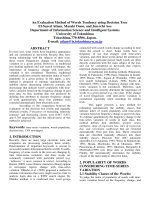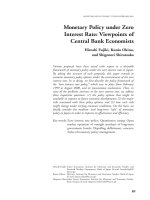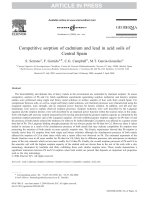Measure of Central Tendency
Bạn đang xem bản rút gọn của tài liệu. Xem và tải ngay bản đầy đủ của tài liệu tại đây (435.89 KB, 74 trang )
/>#1: Measure of Central Tendency
------------------------------A measure of central tendency is a summary statistic that represents the center
point or typical value of a dataset. These measures indicate where most values in a
distribution fall and are also referred to as the central location of a distribution. It
can bethought as the tendency of data to cluster around a middle value.
/>The following are the various measures of central tendency:
1. Arithmetic Mean
2. Weighted Mean
3. Median
4. Mode
5. Geometric Mean
6. Harmonic Mean
hashtag#statistics hashtag#statisticsfordatascience
#2: Some Symbols used in Statistics
hashtag#statistics hashtag#statisticsfordatascience
/>
#3: Significance of the Measure of Central Tendency
---------------------------------------------------------1. To get a single representative value (Summary Statistics)
2. To condense data
3. To facilitate comparison
4. Helpful in further statistical analysis
hashtag#statistics hashtag#statisticsfordatascience
#4:Properties of a Good Average
---------------------------1. It should be simple to understand
2. It should be easy to calculate
3. It should be rigidly defined
4. It should be liable for algebraic manipulations
5. It should be least affected by sampling fluctuations
6. It should be based on all the observations
7. It should be possible to calculate even for open-end class intervals
8. It should not be affected by extremely small or extremely large observation
hashtag#statistics hashtag#statisticsfordatascience
#5:Properties of Arithmetic Mean
-------------------------------Property 1: Sum of deviations of observations from their mean is zero.
Σ(x – mean) = 0
Property 2: Sum of squares of deviations taken from mean is least in comparison
to the same taken from any other average.
Property 3: Arithmetic mean is affected by both the change of origin and scale.
hashtag#statistics hashtag#statisticsfordatascience
#6: Merits and Demerits of Arithmetic Mean
-------------------------------------------Merits of Arithmetic Mean
1. It utilizes all the observations
2. It is rigidly defined
3. It is easy to understand and compute
4. It can be used for further mathematical treatments.
Demerits of Arithmetic Mean
1. It is badly affected by extremely small or extremely large values
2. It cannot be calculated for open end class intervals
3. It is generally not preferred for highly skewed distributions
hashtag#statistics hashtag#statisticsfordatascience
#7:Median
---------Median is that value of the variable which divides the whole distribution into two
equal parts. Data should be arranged in ascending or descending order of
magnitude. For odd number of observations, the median is the middle value of the
data. For even
number of observations, there will be two middle values. So we take the
arithmetic mean of these two middle values. Number of the observations below
and above the median, are same.
Merits and Demerits of Median
-----------------------------Merits
-----1. It is rigidly defined;
2. It is easy to understand and compute
3. It is not affected by extremely small or extremely large values
Demerits
--------1. In case of even number of observations we get only an estimate of the median
by taking the mean of the two middle values. We don’t get its exact value
2. It does not utilize all the observations. The median of 1, 2, 3 is 2. If the
observation 3 is replaced by any number higher than or equal to 2 and if the
number 1 is replaced by any number lower than or equal to 2, the median value
will be unaffected. This means 1 and 3 are not being utilized
3. It is not amenable to algebraic treatment
4. It is affected by sampling fluctuations
hashtag#statistics hashtag#statisticsfordatascience
#8: Mode
--------Highest frequent observation in the distribution is known as mode.
Merits and Demerits of Mode
----------------------------Merits
-----1. Mode is the easiest average to understand and also easy to calculate
2. It is not affected by extreme values
3. It can be calculated for open end classes
4. As far as the modal class is confirmed the pre-modal class and the post modal
class are of equal width
5. Mode can be calculated even if the other classes are of unequal width
Demerits
--------
1. It is not rigidly defined. A distribution can have more than one mode
2. It does not utilize all the observations
3. It is not amenable to algebraic treatment
4. It is greatly affected by sampling fluctuations
hashtag#statistics hashtag#statisticsfordatascience
#9:Relationship between Mean, Median and Mode
--------------------------------------------For a symmetrical distribution the mean, median and mode coincide. But if the
distribution is moderately asymmetrical, there is an empirical relationship
between them. The relationship is
Mean – Mode = 3 (Mean – Median)
Mode = 3 Median – 2 Mean
Using this formula, we can calculate mean/median/mode if other two of them are
known.
hashtag#statistics hashtag#statisticsfordatascience
#10: Geometric Mean Special
----------------------------1. All the observations for which we want to find the Geometric Mean should be
non-zero positive values.
2. if GM1 and GM2 are Geometric Means of two series-Series of sizes n and m
respectively, then the Geometric Mean of the combined series is given by the
formula
Log GM = (n logGM1 + m logGM2) / (n + m)
hashtag#statistics hashtag#statisticsfordatascience
#11: Geometric Mean
-------------------Geometric Mean (GM) is used for averaging ratios or proportions. It is used when
each item has multiple properties that have different numeric ranges. It gives high
weight to lower values. It normalizes the differently-ranged values. Geometrically,
GM of two numbers, a and b, is the length of one side of a square whose area is
equal to the area of a rectangle with sides of lengths a and b. Similarly, GM of
three numbers, a, b, and c, is the length of one edge of a cube whose volume is the
same as that of a cuboid with sides whose lengths are equal to the three given
numbers and so on.
Example of Scenario where GM is useful: In film and video to choose aspect ratios
(the proportion of the width to the height of a screen or image). It’s used to find a
compromise between two aspect ratios, distorting or cropping both ratios equally.
hashtag#statistics hashtag#statisticsfordatascience
#12: Relation between Arithmetic Mean, Geometric Mean and Harmonic Mean
-------------------------------------------------------------------------1. AM ≥ GM ≥ HM
2. GM = sqr(AM.HM) (for two variables)
3. For any n, there exists c>0 such that the following holds for any n-tuple of
positive reals:
AM+cHM>=(1+c)GM.
hashtag#statistics hashtag#statisticsfordatascience
#13: Partition Values, Quartiles, Deciles ans Percentiles
-------------------------------------------------------------Partition values: Partition values are those values of variable which divide the
distribution into a certain number of equal parts. The data should be arranged in
ascending or descending order of magnitude. Commonly used partition values are
quartiles, deciles and percentiles.
Quartiles: Quartiles divide whole distribution in to four equal parts. There are
three quartiles.
Deciles: Deciles divide whole distribution in to ten equal parts. There are nine
deciles.
Percentiles divide whole distribution in to 100 equal parts. There are ninety nine
percentiles.
hashtag#statistics hashtag#statisticsfordatascience
#14: Measure of Dispersion/Variation
--------------------------------According to Spiegel, the degree to which numerical data tend to spread about an
average value is called the variation or dispersion of data. This points out as to
how far an average is representative of the entire data. When variation is less, the
average closely represents the individual values of the data and when variation is
large; the average may not closely represent all the units and be quite unreliable.
Following are the different measures of dispersion:
1. Range
2. Quartile Deviation
3. Mean Deviation
4. Standard Deviation and Variance
hashtag#statistics hashtag#statisticsfordatascience
#15: Significance of Measures of Dispersion
-------------------------------------------Measures of dispersion are needed for the following four basic purposes:
1. Measures of dispersion determine the reliability of an average value means to
how far an average is representative of the entire data. When variation is less, the
average closely represents the individual values of the data and when variation is
large; the average may not closely represent that value.
2. Measuring variation helps determine the nature and causes of variations in
order to control the variation itself.
3. The measures of dispersion enable us to compare two or more series with
regard to their variability. The relative measures of dispersion may also
determine the uniformity or consistency. Smaller value of relative measure of
dispersion implies greater uniformity or consistency in the data.
4. Measures of dispersion facilitate the use of other statistical methods. In other
words, many powerful statistical tools in statistics such as correlation analysis, the
testing of hypothesis, the analysis of variance, techniques of quality control, etc.
are based on different measures of dispersion.
hashtag#statistics hashtag#statisticsfordatascience
#16: Range
-----------Range is the simplest measure of dispersion. It is defined as the difference
between the maximum value of the variable and the minimum value of the
variable in the distribution. Range has unit of the variable and is not a pure
number.
Its merit lies in its simplicity.
The demerit is that it is a crude measure because it is using only the maximum and
the minimum observations of variable. If a single value lower than the minimum or
higher than the maximum is added or if the maximum or minimum value is deleted
range is seriously affected.
However, it still finds applications in Order Statistics and Statistical Quality Control.
It can be defined as
R = Xmax - Xmin
where, Xmax: Maximum value of variable and
Xmin : Minimum value of variable.
hashtag#statistics hashtag#statisticsfordatascience
#17: Coefficient of Range
--------------------------Coefficient of Range is defined as the relative measure of the dispersion of the
range. It is the ratio of difference of highest value and smallest value of the
distribution to their sum. It is a pure number as it does not have unit.
Coefficient of Range is zero when Range is zero.
Formula for Coefficient of Range: (Xmax - Xmin)/(Xmax + Xmin)
hashtag#statistics hashtag#statisticsfordatascience
#18: Quartile Deviation
-----------------------Let Q1 and Q3 are the first quartile and the third quartile respectively. (Q3 – Q1)
gives the inter quartile range. The semi inter quartile range which is also known as
Quartile Deviation (QD) is given by
Quartile Deviation (QD) = (Q3 – Q1) / 2
Relative measure of Q.D. known as Coefficient of Q.D. and is defined as
Cofficient of QD = (Q3 – Q1) /(Q3 + Q1)
The quartile deviation is a slightly better measure of dispersion than the range, but
it ignores the observations on the tails of distribution.
Coefficient of quartile deviation is a pure number without unit.
For symmetric distribution (such as normal distribution where mean and mode are
same), coefficient of quartile deviation is equal to the ration of quartile deviation
and mean value of distribution.
hashtag#statistics hashtag#statisticsfordatascience
#19: Mean Deviation
---------------------Mean deviation is defined as average the absolute values of deviation from any
arbitrary value viz. mean, median, mode, etc. It is often suggested to calculate it
from the median because it gives least value when measured from the median.
The deviation of an observation xi from the assumed mean A is defined as
(xi – A).
#20: Variance
-------------
Variance is the average of the square of deviations of the values taken from mean.
Taking a square of the deviation is a better technique to get
rid of negative deviations.
Variance is defined as
#21: Variance of Combined Series
-------------------------------If there are two or more populations and the information about the means and
variances of those populations are available then we can obtain the combined
variance of several populations. If n1, n2,..., nk are the sizes, x1 bar , x2 bar ,…, xk
bar are the means and σ1 square , σ2 square ,…,σk
square are the variances of k populations, then the combined variance is given by
#22: Standard Deviation
-----------------------Standard Deviation is a statistic that measures the dispersion of a data set relative
to its mean and is calculated as the square root of the variance.
It is calculated as the square root of variance by determining the variation
between each data point relative to the mean. If the data points are further from
the mean, there is a higher deviation within the data set; thus, the more spread
out the data, the higher the standard deviation.
#23: Root Mean Square Deviation
----------------------------------Root Mean Square Root Mean Square Deviation (RMSD) is a statistic that
measures the dispersion of a dataset relative to its mean and is calculated as the
square root of mean deviation(deviation from Assumed Mean). if assumed mean is
equal to mean, then RMSD is called standard deviation.
Root Mean Square Deviation is defined as
#24: Coefficient of Variation
---------------------------------The coefficient of variation (CV) is a statistical measure of the dispersion of data
points in a data series around the mean. The coefficient of variation represents the
ratio of the standard deviation to the mean, and it is a useful statistic for
comparing the degree of variation from one data series to another, even if the
means are drastically different from one another.
#25: Measure of Central Tendency and Measure of Dispersion
-------------------------------------------------------------While average (measure of central tendency) gives the value around which a
distribution is scattered, measure of dispersion tells how it is scattered. So if one
suitable measure of average and one suitable measure of dispersion is calculated
(say mean and SD), we get a good idea of the distribution even if the distribution is
large.
hashtag#statistics hashtag#statisticsfordatascience
#26: Moments
-------------Moments are a set of statistical parameters to measure a distribution. They are
the arithmetic means of first, second, third and so on, i.e. rth power of the
deviation taken from either mean or an arbitrary point of a distribution. They
represent a convenient and unifying method for summarizing many of the most
commonly used statistical measures such as measures of tendency, variation,
skewness and kurtosis.
Moments can be classified in raw and central moment. Raw moments are
measured about any arbitrary point A (say). If A is taken to be zero then raw
moments are called moments about origin. When A is taken to be Arithmetic
mean we get central moments. The first raw moment about origin is mean
whereas the first central moment is zero. The second raw and central moments
are mean square deviation and variance,
respectively. The third and fourth moments are useful in measuring skewness and
kurtosis.
#27: Skewness
--------------Lack of symmetry is called skewness for a frequency distribution. It is a measure of
asymmetry of the frequency distribution of a real-valued random variable
If the distribution is not symmetric, the frequencies will not be uniformly
distributed about the centre of the distribution. In Statistics, a frequency
distribution is called symmetric if mean, median and mode coincide. Otherwise,
the distribution becomes asymmetric. If the right tail is longer, we get a positively
skewed distribution for which mean > median > mode while if the left tail is
longer, we get a negatively skewed distribution for which mean < median <
mode.
The example of the Symmetrical curve, Positive skewed curve and Negative
skewed curve are given as follows:
#28: Difference between Variance and Skewness
---------------------------------------------- Variance tells us about the amount of variability while skewness gives the
direction of variability.
- In business and economic series, measures of variation (e.g.variance) have
greater practical application than measures of skewness. However, in medical and
life science field measures of skewness have greater practical applications than the
variance.
hashtag#statistics hashtag#statisticsfordatascience
#29: Why skweness occurs? How to overcome skewness?
--------------------------------------------------------------------
When data is not distributed normally/symmetrically from mean, skewness occurs.
The reason of occurance of skewness is occurance of excess of low values or high
values in the distribution.
Skewness can be overcomed by using transformation techniques such as log
transformation or standarising(scaling). The transformed distribution would be
normally distributed or nearly normally distributed.
In data science paradigm, skewness is related to imbalanced class and existance of
outliers. For undoing the effect of skewness, we can apply normalization
techniques (such as transformation), resampling and outliers removal etc.
hashtag#statistics hashtag#statisticsfordatascience
#30: Absolute Measures of Skewness
----------------------------------Measures of skewness can be both absolute as well as relative. Since in a
symmetrical distribution mean, median and mode are identical more the mean
moves away from the mode, the larger the asymmetry or skewness. An absolute
measure of skewness can not be used for purposes of comparison
because of the same amount of skewness has different meanings in distribution
with small variation and in distribution with large variation.
Following are the absolute measures of skewness:
1. Skewness (Sk) = Mean – Median
2. Skewness (Sk) = Mean – Mode
3. Skewness (Sk) = (Q3 - Q2) - (Q2 - Q1)
In general, we do not calculate these absolute measrues but we calculate the
relative measures which are called coefficient of skewness.
Coefficient of skewness are pure numbers independent of units of measurements.
hashtag#statistics hashtag#statisticsfordatascience
#31: Relative Measures of Skewness
------------------------------------In order to make valid comparison between the skewness of two or more
distributions we have to eliminate the distributing influence of variation. Such
elimination can be done by dividing the absolute skewness by standard deviation.
The following are the important methods of measuring relative
skewness:
1. Beta and Gamma Coefficient of Skewness (based on second and third central
moment)
2. Karl Pearson’s Coefficient of Skewness (based on first and second central
moment)
3. Bowleys’s Coefficient of Skewness (based on quartiles)
4. Kelly’s Coefficient of Skewness (based on percentile/decile)
hashtag#statistics hashtag#statisticsfordatascience
#32: Some facts about Skewness
-----------------------------------
- If the value of mean, median and mode are same in any distribution, then the
skewness does not exist in that distribution. Larger the difference in
these values, larger the skewness.
- If sum of the frequencies are equal on the both sides of mode then skewness
does not exist.
- If the distance of first quartile and third quartile are same from the median then
a skewness does not exist. Similarly if deciles (first and ninth) and percentiles (first
and ninety nine) are at equal distance from the median, then there is no
asymmetry.
- If the sums of positive and negative deviations obtained from mean, median or
mode are equal then there is no asymmetry.
- If a graph of a data become a normal curve and when it is folded at middle and
one part overlap fully on the other one then there is no asymmetry.
hashtag#statistics hashtag#statisticsfordatascience
#33: Concept of Kurtosis
----------------------------If we have the knowledge of the measures of central tendency, dispersion and
skewness, even then we cannot get a complete idea of a distribution. In
addition to these measures, we need to know another measure to get the
complete idea about the shape of the distribution which can be studied with
the help of Kurtosis. Prof. Karl Pearson has called it the “Convexity of a Curve”.
Kurtosis gives a measure of flatness of distribution.
The degree of kurtosis of a distribution is measured relative to that of a normal
curve. The curves with greater peakedness than the normal curve are called
“Leptokurtic”. The curves which are more flat than the normal curve are called
“Platykurtic”. The normal curve is called “Mesokurtic.” The following describes the
three different curves mentioned above:
#34: Measure of Kurtosis
---------------------------
#35: Scale of Measurement
------------------------------
#36: Types of Data
---------------------N.B.: Last basis can also be read as "On the basis of source of data"
#37: Census vs Sampling on Population
--------------------------------------------
#38: Statistics and Statistic
--------------------------------There is a very common misconception and confusion about the word in singular
sense- “STATISTIC” and in plural sense “STATISTICS”
The characteristic of population is called parameter and the characteristic of
sample is called STATISTIC. It is a single measure of some attribute of a sample. For
example, Xbar, which is sample mean. It is used to estimate the parameter (such
as mue, population mean) for the population.
Statistics is a branch of mathematics dealing with data collection, organization,
analysis, interpretation and presentation.
hashtag#statistics hashtag#statisticsfordatascience
#40: Different Types of Population
-------------------------------------Based on Number:
- Finite Population: Population containing finite number of units or observations.
E.g., the population of students in a class, the population of bolts produced in a
factory in a day, the population of books in a library, etc. In these examples the
number of units in the population is finite in numbers.
- Infinite Population: A population containing infinite (uncountable) number of
units or observations. E.g., the population of particles in a salt bag, the population
of stars in the sky, etc. In these examples the number of units in the population is
not finite.
But theoretically sometimes, populations of too large in size are assumed infinite.
Based on subject:
-Real Population: A population comprising the items or units which are all
physically present. All of the examples given above are examples of a real
population.
-Hypothetical Population:A population consisting the items or units which are not
physically present but the existence of them can only be imagined or
conceptualized. E.g., the population of heads or tails in successive tosses of a coin
a large number of times is considered as hypothetical population.
hashtag#statistics hashtag#statisticsfordatascience
#41: Sampling Distribution of Sample Mean
----------------------------------------We draw all possible samples of same size from the population and calculate the
sample mean for each sample. After calculating the value of sample mean for each
sample we observed that the values of sample mean vary from sample to sample.
Then the sample mean is treated as random variable and a probability distribution
is constructed for the values of sample mean. This probability distribution is known
as sampling distribution of sample mean. Therefore, the sampling distribution of
sample mean can be defined as: “The probability distribution of all possible values
of sample mean that would be obtained by drawing all possible samples of the
same size from the population is called sampling distribution of sample mean or
simply says sampling distribution of mean.”
hashtag#statistics hashtag#statisticsfordatascience
#42: Asymptotic Theory
--------------------------In Statistics, asymptotic theory, or large sample theory (LST), is a generic
framework for assessment of properties of estimators and statistical tests. Within
this framework, it is typically assumed that the sample size n grows indefinitely,
and the properties of statistical procedures are evaluated in the limit as n tends to
infinity. In practice, a limit evaluation is treated as being approximately valid for
large finite sample sizes, as well. The importance of the asymptotic theory is that it
often makes possible to carry out the analysis and state many results which cannot
be obtained within the standard “finite-sample theory”.
hashtag#statistics hashtag#statisticsfordatascience
#43:Independent and identically distributed (IID)random variables
----------------------------------------------------------------Identically Distributed means that there are no overall trends–the distribution
doesn’t fluctuate and all items in the sample are taken from the same probability
distribution. Independent means that the sample items are all independent
events. In other words, they aren’t connected to each other in any way.
In probability theory and statistics, a collection of random variables is independent
and identically distributed if each random variable has the same probability
distribution as the others and all are mutually independent. This property is
usually called Independent and identically distributed (IID)random variables.
hashtag#statistics hashtag#statisticsfordatascience
#44: Random Variable
-------------------When the value of a variable is determined by a random event, that variable is
called a random variable. It gives numbers to outcomes of random events.
Random variables can be discrete or continuous. A random variable that may
assume only a finite number or an infinite sequence of values is said to be discrete;
one that may assume any value in some interval on the real number line is said to
be continuous. For instance, a random variable representing the number of
automobiles sold at a particular dealership on one day would be discrete, while a
random variable representing the weight of a person in kilograms (or pounds)
would be continuous.
hashtag#statistics hashtag#statisticsfordatascience
#45: Frequency Distribution
---------------------------Frequency distribution is a representation, either in a graphical or tabular format,
that displays the number of observations within a given interval(for continuous
variable) or the number of observations per distinct value(categorical or discrete
variable) . The interval size depends on the data being analyzed and the goals of
the analyst. The intervals must be mutually exclusive and exhaustive. Frequency
distribution is mostly used for summarizing categorical data.
As a statistical tool, a frequency distribution provides a visual representation for
the distribution of observations within a particular test. Analysts often use
frequency distribution to visualize or illustrate the data collected in a sample. For
example, the height of children can be split into several different categories or
ranges. In measuring the height of 50 children, some are tall, and some are short,
but there is a high probability of a higher frequency or concentration in the middle
range. The most important factors for gathering data are that the intervals used
must not overlap and must contain all of the possible observations.
hashtag#statistics hashtag#statisticsfordatascience
#46: Cumulative distribution functions (c.d.f.)
---------------------------------------------Cumulative distribution functions describe real random variables. Suppose that X is
a random variable that takes as its values real numbers. Then the cumulative
distribution function F for X is the function whose value at a real number x is the
probability that X takes on a value less than or equal to x.
F(x)=P(X≤x)
Each c.d.f.F has the following four properties:
- F is a non decreasing function
- F is right continuous
- limx→∞F(x)=1
- limx→−∞F(x)=0
Conversely, any function F with above four properties is the c.d.f. of a real random
variable.
For a discrete random variable, the c.d.f. is a step function.









